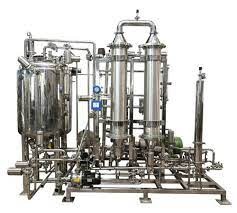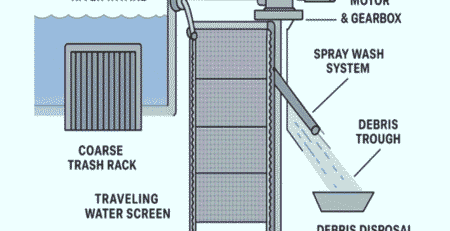Cross Flow Filtration – Treatment of Industrial Wastewater
Cross Flow Filtration Overview:
In cross flow filtration majority of feed flow instead of going into the filter travel tangentially across the surface of the filter. This allows the filter unit to be operational for a long time because the filter cake gets washed away during the filtration process. This type of filtration is mostly suitable for small sizzed solids as solid material can block the surface of filter with dead end filtration.
The driving force for cross flow filtration is transmembrane pressure. It is defined as the pressure difference that exists between two sides of a membrane. During the process the filtration efficiency can decrease with the increase in permeate velocity due to decrease of transmembrane pressure. This can consume a lot of time in treatment of water. Flow rate can be increased to prevent this.

Cross Filtration Working principle:
Cross filtration is done by indirectly applying flow across the membrane. The feed flow accumulates in the membrane surface and the filtrate goes through whereas the solution gets absorbed at the opposite end of the membrane.

Working:
The most important parameters to consider in cross flow filtration are:
- Pressure present at various points in the system
- Glow rate in the system at various points
- Process time
During the process of cross filtration, the feed water is passed across the surface of the filter membrane. This is done at positive pressure relative to permeate side. The material that is smaller in size than the size of the pores present on the filter passes through the filter to the other side as filtrate or permeate whereas the large size particles are retained on the feed side and is called as retentate. The trapped particles on the filter surface het rubbed off dye to tangential motion of the bulk of fluid across the membrane. Therefore, cross filtration can occur continuously without binding.

Advantages versus traditional flow:
- As the formation of filter cake can be prevented in cross flow filtration, it is possible to achieve a high liquid removal rate.
- Process feed can be further processed as it remains in the form of mobile slurry.
- Particles can be fractionated by size.
- Has tubular pinch effect.
Dead-End Filtration:
The most prevalent applications for dead-end filtration are laboratory and medicinal filtration. Dead-end filtering has the advantage of high product recovery and ease of use. However, due to internal pore obstruction, the filter cartridges (depth filters) cannot be backwashed or cleaned and must be destroyed.
There are two types of dead-end filtration applications: flux-limited and capacity-limited. Membrane permeability (a function of pore size distribution, porosity, and thickness) and solution characteristics influence filtration flux (e.g., viscosity, density, and temperature).
Capacity, on the other hand, is proportional to the rate at which the membrane fouls. The amount of fouling will be determined by the solution composition as well as the process circumstances. Fouling raises the pressure in the filter. As a result, if the filtration process is run at constant pressure, the flow rate must be reduced to account for the increased fouling, and flux will drop as the process time increases.

Techniques to improve the performance of cross flow filtration:
Backwashing: Backwashing can help in lifting the fouling layer from the surface of membrane by inverting transmembrane pressure using a secondary pump causing the permeate to flow back into the feed.
Alternating tangential flow: Membrane fouling can be prevented and retained particles can be dislodged by applying a \n alternating tangential flow using a diaphragm pump.
Clean in place: After extensive use of membranes the fouling on them can be removed by using clean in place system. In clean in system process detergents, acids, alkalis and reactive agents like sodium hypochlorite are eased to clean the fouling from the membrane.
Concentration: Permeate flow can occur by reducing the volume of the fluid. This allows the large particles to be retained and concentrated whereas the solute solvent and particles that are smaller in size than the pore size of membrane to pass through it.
Diafiltration: The addition of fresh solvent to the feed can remover permeate components from the slurry while keeping the volume constant. This process is analogous to the washing of filter cake for removal of the soluble components.
Applications of Cross Flow Filtration:
- Separates and purifies biomolecules
- Immunology, protein chemistry, biochemistry, microbiology, and molecular biology are some of the fields where it might be applied.
| Application | Comments | Comments |
| Lysate or cell clarification | Helps in separation of target molecules from intact cells, cell debris and molecular aggregates.
Helps in recovery of target molecules in the permeate. |
Upstream processing |
| Cell harvesting | Cells are separated from the fermentation broth.
Recovery of cells in the retentate. |
|
| Diafiltration | Buffer exchange. The retentate is where the product is retrieved. | Downstream Process
Product preparation |
| Product concentration | Concentration of product solution prior to further processing by removal of solvent and small molecules.
The retentate is where the product is retrieved. |
|
| Product fractionation | Separates components on the basis of molecular size. | Downstream processing |
Table 1: Typical uses of cross flow filtration
Advantages of Cross Flow Filtration:
- Ease: The system is easy to operate.
- Easy to set up and use: The system can be easily set up.
- Works rapidly: Cross flow filtration is a continuous process and can rapidly separate contaminants from water and purify it.
- Saves time: Concentration and diafiltration of the sample can be done on the same system.
- Pross large or small samples: Cross flow filtration has the ability to process sample ranging from 10 mL to thousands of litres.
- Variations: Can handle large variations of solid concentration.
- Particle size: has the ability to handle particle size of different varieties.
- High purity: Results in product with high purity.
Disadvantages of Cross Flow Filtration:
- The system has high initial flux.
- Can rapidly create a fouling layer if transmembrane pressure is not controlled.
- Can be costly.
- The filters have to be replaced at regular intervals.
Cross Flow Filtration Frequently Asked Questions
1) What is cross flow filtration process?
By flowing the solution along the surface of a membrane, cross-flow filtration, often referred to as tangential flow filtration, separates particles in solution. The pressure difference across the membrane allows liquid to move through it.
2) Why is cross flow more efficient?
High efficiency is achieved through cross flow heat exchangers, and the amount of surface area the flow channels cover determines how much heat is transferred. This implies that heat recovery increases with heat exchanger size.
3) Is cross flow more efficient or counter flow?
A cross flow tower is typically favored for a number of factors, chief among them being overall efficiency and serviceability. A counterblow tower, which is taller but has a smaller footprint, can be your only choice if you have limited space because cross flow towers have a greater footprint.
4) What is cross flow Micro filtered?
To remove fat, lactose, aggregated denatured proteins, and any other non-dissolved particles, the Cross Flow Microfiltration procedure uses ceramic membranes in a gentle, low temperature, non-chemical manner.
5) What are the advantages of cross flow filtration over dead end filtration?
Cross-Flow Filtration Advantages over Dead-End Filtration
The capacity to clean accumulation off the membrane’s surface. A filter aid is not required. Lack of accumulation and filter cake increases the lifespan of the filter media. Prevents the membrane from becoming permanently fouled.










